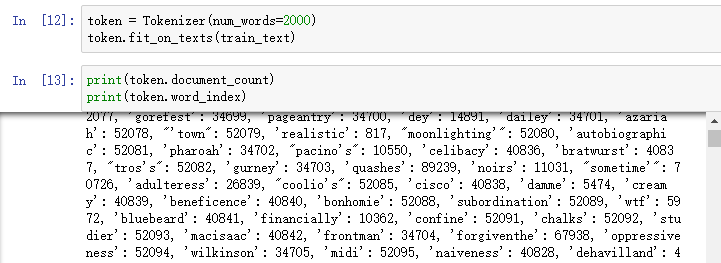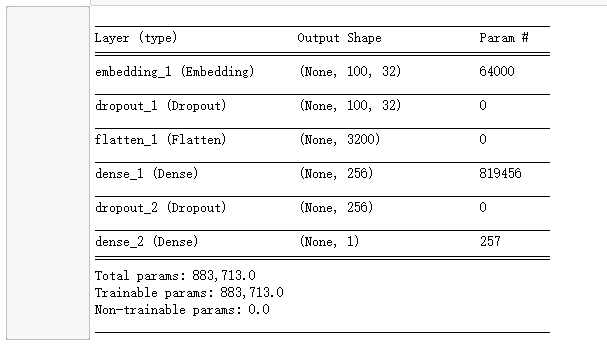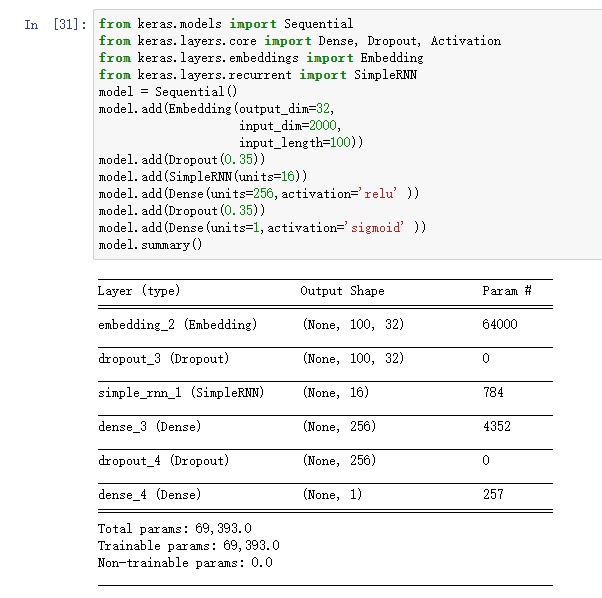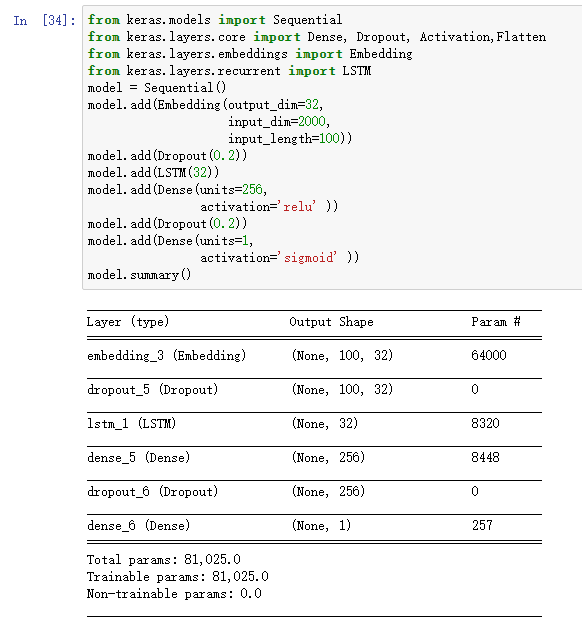
1 # coding: utf-8 2 3 # In[1]: 4 5 6 import urllib.request 7 import os 8 import tarfile 9 10 11 # In[2]: 12 13 14 url="http://ai.stanford.edu/~amaas/data/sentiment/aclImdb_v1.tar.gz" 15 filepath="example/data/aclImdb_v1.tar.gz" 16 if not os.path.isfile(filepath): 17 result=urllib.request.urlretrieve(url,filepath) 18 print('downloaded:',result) 19 if not os.path.exists("example/data/aclImdb_v1/aclImdb"): 20 tfile = tarfile.open("data/aclImdb_v1.tar.gz", 'r:gz') 21 result=tfile.extractall('data/') 22 23 24 # In[3]: 25 26 27 from keras.datasets import imdb 28 from keras.preprocessing import sequence 29 from keras.preprocessing.text import Tokenizer 30 31 32 # In[4]: 33 34 35 import re 36 def rm_tags(text): 37 re_tag = re.compile(r'<[^>]+>') 38 return re_tag.sub('', text) 39 40 41 # In[5]: 42 43 44 import os 45 def read_files(filetype): 46 path = "example/data/aclImdb_v1/aclImdb/" 47 file_list=[] 48 49 positive_path=path + filetype+"/pos/" 50 for f in os.listdir(positive_path): 51 file_list+=[positive_path+f] 52 53 negative_path=path + filetype+"/neg/" 54 for f in os.listdir(negative_path): 55 file_list+=[negative_path+f] 56 57 print('read',filetype, 'files:',len(file_list)) 58 all_labels = ([1] * 12500 + [0] * 12500) 59 60 all_texts = [] 61 for fi in file_list: 62 with open(fi,encoding='utf8') as file_input: 63 all_texts += [rm_tags(" ".join(file_input.readlines()))] 64 65 return all_labels,all_texts 66 67 68 # In[6]: 69 70 71 y_train,train_text=read_files("train") 72 73 74 # In[7]: 75 76 77 y_test,test_text=read_files("test") 78 79 80 # In[8]: 81 82 83 train_text[0] 84 85 86 # In[9]: 87 88 89 y_train[0] 90 91 92 # In[10]: 93 94 95 train_text[12500] 96 97 98 # In[11]: 99 100 101 y_train[12500] 102 103 104 # In[12]: 105 106 107 token = Tokenizer(num_words=2000) 108 token.fit_on_texts(train_text) 109 110 111 # In[13]: 112 113 114 print(token.document_count) 115 print(token.word_index) 116 117 118 # In[14]: 119 120 121 x_train_seq = token.texts_to_sequences(train_text) 122 x_test_seq = token.texts_to_sequences(test_text) 123 124 125 # In[15]: 126 127 128 print(x_train_seq[0]) 129 130 131 # In[16]: 132 133 134 x_train = sequence.pad_sequences(x_train_seq, maxlen=100) 135 x_test = sequence.pad_sequences(x_test_seq, maxlen=100) 136 137 138 # In[17]: 139 140 141 x_train[0] 142 143 144 # In[18]: 145 146 147 from keras.models import Sequential 148 from keras.layers.core import Dense, Dropout, Activation,Flatten 149 from keras.layers.embeddings import Embedding 150 model = Sequential() 151 model.add(Embedding(output_dim=32, 152 input_dim=2000, 153 input_length=100)) 154 model.add(Dropout(0.2)) 155 model.add(Flatten()) 156 model.add(Dense(units=256, 157 activation='relu' )) 158 model.add(Dropout(0.2)) 159 model.add(Dense(units=1, 160 activation='sigmoid' )) 161 model.summary() 162 163 164 # In[19]: 165 166 167 model.compile(loss='binary_crossentropy', 168 optimizer='adam', 169 metrics=['accuracy']) 170 train_history =model.fit(x_train, y_train,batch_size=100, 171 epochs=10,verbose=2, 172 validation_split=0.2) 173 174 175 # In[20]: 176 177 178 get_ipython().magic('pylab inline') 179 import matplotlib.pyplot as plt 180 def show_train_history(train_history,train,validation): 181 plt.plot(train_history.history[train]) 182 plt.plot(train_history.history[validation]) 183 plt.title('Train History') 184 plt.ylabel(train) 185 plt.xlabel('Epoch') 186 plt.legend(['train', 'validation'], loc='upper left') 187 plt.show() 188 189 190 # In[21]: 191 192 193 show_train_history(train_history,'acc','val_acc') 194 show_train_history(train_history,'loss','val_loss') 195 196 197 # In[22]: 198 199 200 scores = model.evaluate(x_test, y_test, verbose=1) 201 scores[1] 202 203 204 # In[23]: 205 206 207 probility=model.predict(x_test) 208 209 210 # In[24]: 211 212 213 probility[:10] 214 215 216 # In[25]: 217 218 219 probility[12500:12510] 220 221 222 # In[26]: 223 224 225 predict=model.predict_classes(x_test) 226 227 228 # In[27]: 229 230 231 predict_classes=predict.reshape(-1) 232 233 234 # In[28]: 235 236 237 SentimentDict={1:'正面的',0:'负面的'} 238 def display_test_Sentiment(i): 239 print(test_text[i]) 240 print('标签label:',SentimentDict[y_test[i]], 241 '预测结果:',SentimentDict[predict_classes[i]]) 242 243 244 # In[29]: 245 246 247 display_test_Sentiment(2) 248 249 250 # In[30]: 251 252 253 display_test_Sentiment(12505) 254 255 256 # In[31]: 257 258 259 from keras.models import Sequential 260 from keras.layers.core import Dense, Dropout, Activation 261 from keras.layers.embeddings import Embedding 262 from keras.layers.recurrent import SimpleRNN 263 model = Sequential() 264 model.add(Embedding(output_dim=32, 265 input_dim=2000, 266 input_length=100)) 267 model.add(Dropout(0.35)) 268 model.add(SimpleRNN(units=16)) 269 model.add(Dense(units=256,activation='relu' )) 270 model.add(Dropout(0.35)) 271 model.add(Dense(units=1,activation='sigmoid' )) 272 model.summary() 273 274 275 # In[32]: 276 277 278 model.compile(loss='binary_crossentropy', 279 optimizer='adam', 280 metrics=['accuracy']) 281 train_history =model.fit(x_train, y_train,batch_size=100, 282 epochs=10,verbose=2, 283 validation_split=0.2) 284 285 286 # In[33]: 287 288 289 scores = model.evaluate(x_test, y_test, verbose=1) 290 scores[1] 291 292 293 # In[34]: 294 295 296 from keras.models import Sequential 297 from keras.layers.core import Dense, Dropout, Activation,Flatten 298 from keras.layers.embeddings import Embedding 299 from keras.layers.recurrent import LSTM 300 model = Sequential() 301 model.add(Embedding(output_dim=32, 302 input_dim=2000, 303 input_length=100)) 304 model.add(Dropout(0.2)) 305 model.add(LSTM(32)) 306 model.add(Dense(units=256, 307 activation='relu' )) 308 model.add(Dropout(0.2)) 309 model.add(Dense(units=1, 310 activation='sigmoid' )) 311 model.summary() 312 313 314 # In[35]: 315 316 317 model.compile(loss='binary_crossentropy', 318 #optimizer='rmsprop', 319 optimizer='adam', 320 metrics=['accuracy']) 321 train_history =model.fit(x_train, y_train,batch_size=100, 322 epochs=10,verbose=2, 323 validation_split=0.2) 324 325 326 # In[36]: 327 328 329 show_train_history(train_history,'acc','val_acc') 330 show_train_history(train_history,'loss','val_loss') 331 scores = model.evaluate(x_test, y_test, verbose=1) 332 scores[1] 333 334 335 # In[ ]:
文本来源于IMDb网络电影数据集。下载,放到合适的路径下,然后,开始。
过滤掉HTML标签。因为数据集中有相关标签。:

之后读取所有数据和目标标签,然后建立字典:

将文本转化为数字串:

格式化数字串长度为100

建立MLP模型,其中嵌入层将每个长度为100的数字串转为100个32维的向量,将文字映射成多维的几何空间向量,让每一个文字有上下的关联性。

编译,训练,绘图,评估后的准确率:

建立RNN模型,有关RNN模型的介绍:https://www.cnblogs.com/bai2018/p/10466418.html

测试评估:

建立LSTM模型,相关介绍:https://www.cnblogs.com/bai2018/p/10466497.html

准确率:

